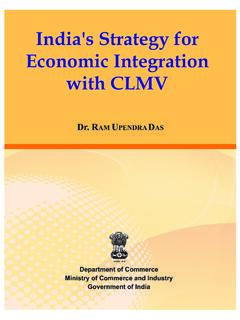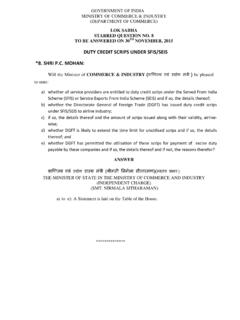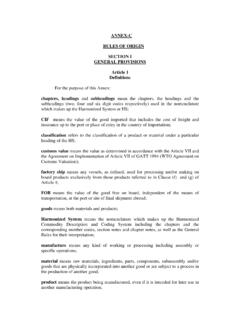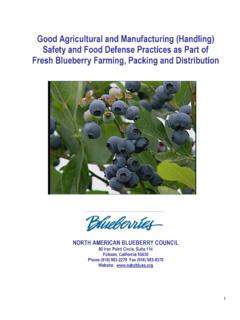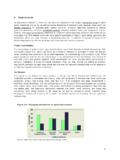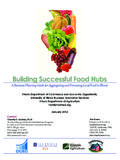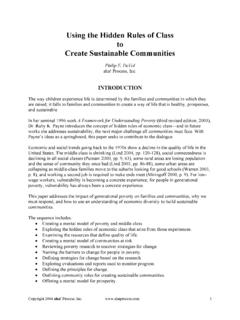Transcription of In consonance with Hon’ble Prime Minister’s vision …
1 In consonance with Hon'ble Prime Minister's vision of Doubling Farmer's Income , Shri Suresh Prabhu, Hon'ble Minister of Commerce and Industry has taken the initiative to come up with an Agriculture Export Policy in larger interest of farmers and agriculture exports. The Ministry of Commerce & Industry has come up with a draft Agriculture Export Policy . which is aimed at doubling the agricultural exports and integrate Indian farmers and agricultural products to the global value chain. Preliminary meeting with stakeholders was conducted to obtain their feedback on the proposed policy. Based on the preliminary inputs a draft policy document is prepared. The draft Agriculture Export Policy is put up in the public domain in order to seek wider consultation and feedback/suggestions from the stakeholders so as to provide the final shape to the Policy. The suggestions may be forwarded in the following mail ids by 5th April, 2018: 1.
2 2. Draft Agriculture Export Policy Department of Commerce Ministry of Commerce and Industry Government of India Contents 1. Introduction 2. Agriculture Export Policy: Objective and vision 3. Current Agri Trade Scenario 4. Elements of the Agri-export Policy Framework 5. Strategic Recommendations Policy Measures Stable Trade Policy Regime Reforms in APMC Act and streamlining of Mandi fee Liberalising Land Leasing norms Infrastructure and Logistics Boost Whole Government Approach to boost exports Greater involvement of State Governments in Agri Exports Identification of a nodal State Department / Agency for promotion of agriculture export Inclusion on agricultural exports in the State Export Policy Infrastructure and Logistics to facilitate agricultural exports Institutional Mechanism at State level and cluster level to support exports 6. Operational Recommendations Focus on Clusters Promoting Value added exports Product development for indigenous commodities and value addition Promote Value added Organic exports Promotion of R&D activities for new product Development for the upcoming markets Marketing and promotion of Produce of India.
3 Infrastructure and Logistics to support agricultural exports Ease of Doing Business (EODB) & Digitization Developing Sea Protocol Establishment of Strong Quality Regimen Establish and maintain single supply chain and standards for domestic and export market. SPS and TBT Response Mechanism Conformity Assessment Self sufficiency and export oriented production Research and Development Miscellaneous A - Creation of Agri-start-up fund Conclusion Abbreviations AEP Agriculture Export Policy AEZ - Agri Export Zones APEDA - Agricultural and Processed Food Products Export Development Authority APMC - Agricultural Produce Marketing Committee ASEAN - Association of Southeast Asian Nations CAGR - Compound Annual Growth Rate CIB - Central Insecticide Board CNSL - Cashew Nut Shell Liquid CPC - Centre for Perishable Cargo CSIR - Council of Scientific & Industrial Research DAC&FW - Department of Agriculture, Cooperation and Farmer Welfare DAHDF - Department of Animal Husbandry, Dairying and Fisheries Deptt.
4 - Department DGFT - Directorate General of Foreign Trade EIC Export Inspection Council E-NAM Electronic National Agriculture Market EU - European Union FAMA - Federal Agricultural Marketing Authority FDI - Foreign direct investment FIEO - Federation of Indian Export Organizations FOB - Free on Board FOREX Foreign Exchange FPO - Farmer Producer Organizations FSSAI- Food Safety and Standards Authority of India FSVPS - Federal Service for Veterinary and Phytosanitary Surveillance (Rosselkhoznadzor). FTA Free Trade Agreement GAP - Good Agricultural Practices GDP - Gross Domestic Product GI - Geographical Indication GoI Government of India GST - Goods and Services Tax HPMC - Himachal Pradesh Horticultural Produce Marketing and Processing Corporation Ltd. IBEF - India Brand Equity Foundation ICAR - Indian Council of Agricultural Research ICD/CFS - Inland Container Depots / Container Freight Stations IP - Intellectual property IQF - Individual Quick Freezing IT Information Technology MEP - Minimum Export Price MIDH - Mission for Integrated Development of Horticulture MoA Ministry of Agriculture MoC - Ministry of Commerce and Industries MoFPI - Ministry of Food Processing Industries MPEDA - Marine Products Exports Development Authority MRL - Maximum Residue Limit MSME - Micro, Small & Medium Enterprises NABL - National Accreditation Board for Testing and Calibration Laboratories NPOP - National Programme on Organic Production NPPO - National Plant Protection Organization NSSO - National Sample Survey Office NTB - Non-Tariff Barriers PPP-IAD - Public-Private Partnership for.
5 Integrated Agriculture Development R&D Research and Development RMP - Residue Monitoring Plan SEZ - Special Economic Zones SHEFEXIL - Shellac & Forest Products Export Promotion Council SHG Self Help Group SPS - Sanitary and phytosanitary measures TBT - Technical Barriers to Trade TIES - Trade Infrastructure for Export Scheme UAE - United Arab Emirates US United States of America US FDA - United States Food and Drug Administration USDA - United States Department of Agriculture WTO - World Trade Organization Draft Agriculture Export Policy Introduction India, with a large and diverse agriculture, is among the world's leading producer of cereals, milk, sugar, fruits and vegetables, spices and seafood products. Indian agriculture continues to be the backbone of our society and it provides livelihood to nearly 58 per cent of our population. India is supporting per cent of world's population with merely per cent of world's land and 4 per cent water resources.
6 Hence, continuous innovation and efforts towards productivity, pre &post-harvest management, processing and value-addition, use of technology and infrastructure creation is an imperative for Indian agriculture. Various studies on fresh fruits and vegetables, fisheries in India have indicated a loss percentage ranging from about 8% to 18% on account of poor post-harvest management, absence of cold chain and processing facilities. Therefore, agro processing and agricultural exports are a key area for us and it is a matter of satisfaction that India's role in global export of agricultural products is steadily increasing. India is currently ranked ninth amongst the major exporters globally as per WTO trade data for 2015. India's share in global exports of agriculture products has increased from 1% a few years ago, to % in 2016. 2. Agriculture Export Policy: Objective and vision A dynamic nation of billion consumers with rising discretionary incomes, changing food patterns, vast farming area and a large population dependent on agriculture has propelled India to the world's center stage - not just as a big consumer market but also as a potential food factory of the world.
7 It has often been suggested that an essential element of Make in India has to be Bake in India , a renewed focus on value addition and on processed agricultural products. The rapidly growing global population and shrinking farmlands, coupled with changing socio-economic, agro-climatic and dietary patterns, have challenged scientists and policymakers to reconsider how we grow and feed billion global citizens. Globalization has ensured that no one remains immune from the ills of hunger and poverty, on one hand, and unhealthy and conspicuous consumption in another part of the world. India's quest, then, is to grow sustainably, trade abundantly and progress harmoniously. Challenges, however, are aplenty; from low farm productivity to poor infrastructure to global price volatility to market access. The vision of Prime Minister Shri Narendra Modi to double farmer's income by 2022 would require a series of interventions to improve production and productivity along with economizing the cost of production.
8 This would also require India to augment its exports to the global market to ensure that farmers get a remunerative price and a marketing channel for their production. There has been a long felt need for a dedicated agricultural export policy in India. With WTO negotiations in full swing and globalization of value chains, India has played an integral role in world agricultural trade in the past one decade. India has played a proactive role in the WTO. negotiations on trade facilitation, public stockholding and the time is ripe for framing a coherent, stable and farmer friendly agricultural export policy. The need for a dedicated policy under Ministry of Commerce and Industries (MoC). overarching umbrella arises due to the federal and administrative structure of the Union and State government. While the Department of Agriculture, Cooperation and Farmer Welfare (DAC&FW) and Department of Animal Husbandry, Dairying and Fisheries (DAHDF) focus on production, post-harvest and boosting farmer income, the Ministry of Food Processing Industries (MoFPI) focuses on value addition, post-harvest losses and employment generation.
9 The MoC, on the other hand, is focused on foreign trade across sectors. There is an increasing need for the Government of India to establish a stable and predictable Agri Export Policy which aims at reinvigorating the entire value chain from export oriented farm production and processing to transportation, infrastructure and market access. The proposed Agri Export Policy is framed with a focus onagri export oriented production, export promotion, better farmer realization and synchronization within GoI. The broad vision is highlighted below. INDIA'S AGRI EXPORT POLICY- OBJECTIVE AND vision . The National Agriculture Export Policy is formulated in line with the vision to double the farmer's income and increase the share of agricultural exports from present ~US$ 30+ Billion to ~US$ 60+ Billion by 2022. To boost high value and value added agricultural exports, focusing on perishables.
10 To promote novel indigenous, Organic, ethnic traditional and non-traditional categories. To provide an institutional mechanism for tackling market access barriers and deal with sanitary and phytosanitary issues. To become one of the top 10 exporting countries of agricultural products and strive to double India's share in world agri exports. Focus on export centric clusters for integrated Commodity Focus Value Chain and Infrastructure Development. 3. Current Agri Trade Scenario World agricultural trade has been relatively stagnant in the last five years (2013-2017). The sharp drop in oil prices was a major contributor to softening of global agricultural commodity prices. In similar vein, India's agricultural trade1 dropped by -5% CAGR from US$ 36 Billion in FY13 to US$ 31 Billion in FY172. However, a comparative analysis of India's ten year agri exports reveals an encouraging picture.
